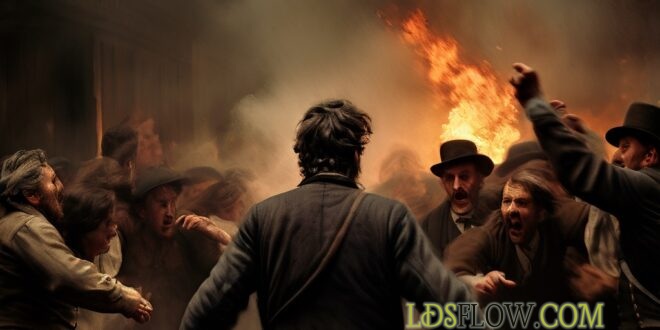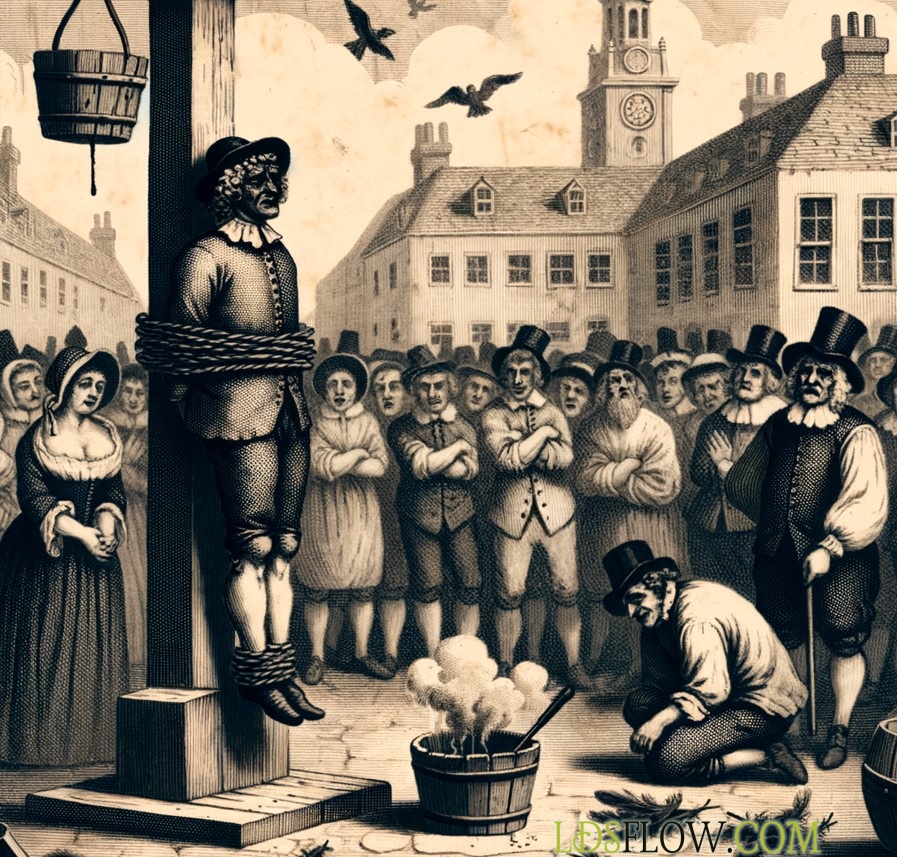In the depths of religious persecution, few incidents stand out as vividly as the tarring and feathering of Joseph Smith, the founder of the Church of Jesus Christ of Latter-day Saints (LDS Church), commonly known as the Mormon Church. This brutal attack, which occurred in the early hours of March 25, 1832, in Hiram, Ohio, would become a defining moment in Smith’s life and in the early history of the Mormon faith.
The Setting
It was a cold spring night in Hiram, Ohio. Joseph Smith, then 26 years old, was staying at the home of John and Elsa Johnson, early converts to Mormonism. Smith had been living there for several months, working on a new translation of the Bible and receiving revelations that would later become part of the Doctrine and Covenants, a sacred text in the LDS faith.
The atmosphere in Hiram and the surrounding area was tense. Smith’s growing religious movement had attracted both fervent followers and vehement critics. His claims of divine revelations and new scripture had stirred up controversy among traditional Christian denominations. Moreover, economic and political tensions in the frontier communities added fuel to the fire of religious disagreement.
The Attack
As Smith slept in the Johnson home that night, little did he know that a mob was gathering outside, intent on silencing him. In the wee hours of the morning, the peace was shattered as an infuriated group burst through the door of the summer kitchen. They pounced on the sleeping Smith and began dragging him out the door.
Smith, suddenly awakened, found himself on the stoop before he fully comprehended what was happening. In a desperate attempt to free himself, he managed to kick one of his attackers in the face, sending the man sprawling. However, this act of defiance only enraged his assailants further. The kicked man, his hands covered in his own blood, grabbed Smith by the throat and choked him until he lost consciousness.
When Smith regained consciousness, he saw his friend and counselor, Sidney Rigdon, lying motionless on the cold ground. Fearing Rigdon was dead, Smith pleaded with the mob for mercy. Their response was chilling: “Call on yer God for help,” they sneered, “We’ll show you no mercy!”
The Brutality Escalates
As more men joined the mob, the violence intensified. They stripped Smith of all his clothes except his shirt collar and proceeded to beat, kick, and scratch him mercilessly. One particularly vicious attacker fell upon Smith “like a mad cat,” scratching his body with his nails while mockingly crying out, “That’s the way the Holy Ghost falls on folks.”
The mob’s intentions became clear: they wanted to hurt Smith, to silence him, but not necessarily to kill him outright. In a horrifying turn of events, someone produced a bucket of hot tar. The mob began smearing the scalding substance over Smith’s already lacerated body, attempting to force the tar paddle into his mouth.
But the brutality didn’t stop there. In a moment that could have proved fatal, the attackers tried to force a vial of poison – aquafortis, or nitric acid – into Smith’s mouth. Had they succeeded, the acid would have burned his throat, ruined his voice, and likely killed him. Smith clenched his jaw and fought back with all his remaining strength. While he managed to prevent them from pouring the acid down his throat, they succeeded in spilling it over his skin, causing severe burns.
The Physical and Spiritual Toll
The attack left Smith with injuries that would plague him for the rest of his life. A patch of his hair was torn out by the roots, never to grow back. He suffered an injury to his side that caused him chronic pain. Most disturbingly, Smith later described an out-of-body experience during the attack, claiming he stood above his body and watched as the mob beat him and poured acid over his face and neck.
The ordeal seemed to stretch on endlessly, but finally, a noise in the distance startled the mob. Fearing discovery, they fled, leaving Smith battered and barely conscious on the ground.
The Aftermath
Slowly and painfully, Smith regained his senses and managed to make his way back to the Johnson home. His wife Emma, standing in the doorway, fainted at the sight of him. Covered only in a blanket, Smith went inside by the fire. His friends spent the entire night carefully peeling and scraping the tar from his body, sometimes taking off layers of skin in the process.
What happened next would become legendary in Mormon history. The very next morning, which happened to be the Sabbath, Smith stood before his congregation and delivered a sermon. Despite his injuries and the trauma of the previous night, he even performed three baptisms that day. This act of resilience and devotion made a lasting impression on both his followers and his attackers.
About a week later, following what he claimed was a divine revelation, Smith set out for an extended visit to Missouri. His determination to continue his religious mission despite the brutal attack demonstrated his unwavering commitment to his faith.
The Motivations Behind the Attack
The tarring and feathering of Joseph Smith was not an isolated incident of violence, but rather part of a pattern of persecution that followed Smith and the early Mormons. But what drove people to such extreme acts?
There were several factors at play:
Religious Opposition: Smith’s claims of new revelations and scripture were seen as heretical by many traditional Christians. His teachings challenged established doctrines and threatened the authority of existing religious leaders.
Economic and Political Tensions: The rapid growth of the Mormon community often led to conflicts with established residents in frontier areas. There were concerns about the Mormons’ increasing economic and political influence.
Personal Vendettas: Some individuals had personal grievances against Smith or other Mormon leaders.
The “Vision” Revelation: A month before the attack, Smith and Rigdon had received a new revelation known as “the Vision” or “the three degrees of glory” (later recorded as Section 76 of the Doctrine and Covenants). This revelation, which described a complex afterlife structure different from traditional Christian views of heaven and hell, had stirred up significant controversy.
Legacy and Impact
The tarring and feathering of Joseph Smith became a powerful symbol within the Mormon faith. It represented the persecution faced by the early church and reinforced the narrative of the Latter-day Saints as a persecuted people chosen by God. This incident, along with other acts of violence against Mormons, strengthened the resolve of Smith’s followers and contributed to a sense of group identity and solidarity.
For Smith himself, the attack was a pivotal moment. It demonstrated both his vulnerability and his resilience. Despite the trauma and ongoing physical effects, he continued to lead and grow his religious movement. The Church of Jesus Christ of Latter-day Saints would go on to become a major world religion, though Smith himself would face further violence, ultimately being killed by a mob in Carthage, Illinois, in 1844.
Conclusion
The tarring and feathering of Joseph Smith stands as a dark chapter in American religious history. It highlights the volatile nature of frontier justice, the challenges faced by religious minorities in 19th century America, and the often violent opposition faced by new religious movements. At the same time, it underscores the power of religious conviction and the ability of faith communities to persevere in the face of persecution.
As we reflect on this incident nearly two centuries later, it serves as a stark reminder of the importance of religious tolerance and the dangers of mob mentality. It also invites us to consider the complex interplay of faith, society, and individual determination that shapes the course of history.





